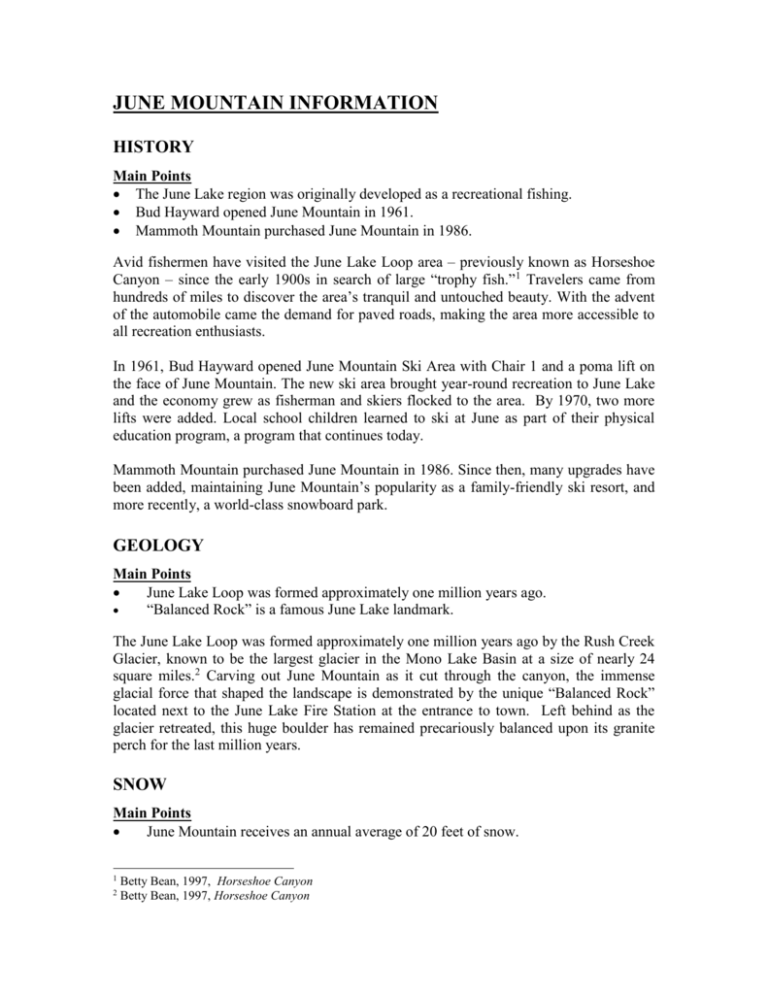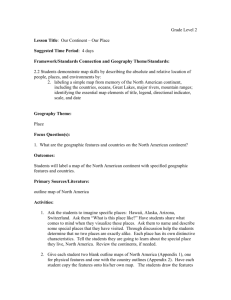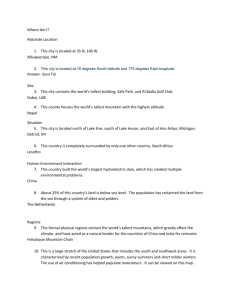Section No. 3 - mammoth host department web site
advertisement

JUNE MOUNTAIN INFORMATION HISTORY Main Points The June Lake region was originally developed as a recreational fishing. Bud Hayward opened June Mountain in 1961. Mammoth Mountain purchased June Mountain in 1986. Avid fishermen have visited the June Lake Loop area – previously known as Horseshoe Canyon – since the early 1900s in search of large “trophy fish.”1 Travelers came from hundreds of miles to discover the area’s tranquil and untouched beauty. With the advent of the automobile came the demand for paved roads, making the area more accessible to all recreation enthusiasts. In 1961, Bud Hayward opened June Mountain Ski Area with Chair 1 and a poma lift on the face of June Mountain. The new ski area brought year-round recreation to June Lake and the economy grew as fisherman and skiers flocked to the area. By 1970, two more lifts were added. Local school children learned to ski at June as part of their physical education program, a program that continues today. Mammoth Mountain purchased June Mountain in 1986. Since then, many upgrades have been added, maintaining June Mountain’s popularity as a family-friendly ski resort, and more recently, a world-class snowboard park. GEOLOGY Main Points June Lake Loop was formed approximately one million years ago. “Balanced Rock” is a famous June Lake landmark. The June Lake Loop was formed approximately one million years ago by the Rush Creek Glacier, known to be the largest glacier in the Mono Lake Basin at a size of nearly 24 square miles.2 Carving out June Mountain as it cut through the canyon, the immense glacial force that shaped the landscape is demonstrated by the unique “Balanced Rock” located next to the June Lake Fire Station at the entrance to town. Left behind as the glacier retreated, this huge boulder has remained precariously balanced upon its granite perch for the last million years. SNOW Main Points June Mountain receives an annual average of 20 feet of snow. 1 2 Betty Bean, 1997, Horseshoe Canyon Betty Bean, 1997, Horseshoe Canyon June’s ski season usually runs from mid-December to April, depending upon snowfall amounts. June Mountain receives an average of 20 feet of snow annually. Similar to Mammoth Mountain, this amount is unusually high for the Eastern Sierra. Normally, storms drop the majority of their snow on the western slope of the Sierra Nevada mountain range. However, like Mammoth, the topography surrounding June Mountain allows storms to reach the mountain and drop large amounts of snow. Unlike Mammoth, however, June Mountain has limited snowmaking capabilities and is mainly dependent upon nature for its coverage. This leads to a ski season that usually runs from December to April. TAMARACK RESORT INFORMATION HISTORY Main Points Tamarack Lodge was originally built in 1924. Mammoth Mountain purchased Tamarack Lodge and Resort in 1998. Tamarack Cross Country Ski Center offers 42 kilometers of groomed tracks. Tamarack Lodge was originally built in 1924 by the Foy family of Los Angeles, who were immortalized by Bob Hope in the movie The Seven Little Foys. The rustic lodge, overlooking the beautiful Twin Lakes, was used by the family to host gatherings of socialites from the entertainment world. In 1927, Tamarack was purchased by the Austin family from Pasadena, who added cabins and developed the property into a summertime fishing resort and wintertime ski destination. Fishermen and families visited from far and wide, leading to a colrful folklore built around the winter skiers and basin caretakers. With no open roads above Mammoth in the winter, all transportation was via dog sled, snowshoes or skis. Winters were long and the caretakers led isolated and adventuresome lives. Pictures from this era – the thirties and forties – can be viewed throughout the lodge and on the walls of the Lakefront Restaurant. In the 1950s and 60s, Tamarack was owned by the Stanford family. In the 60s, the family began keeping the lodge open year-round, leading to the commercial development of skiing in the Lakes Basin. In the mid-70s, the lodge changed ownership again, gaining renown as a center for Nordic skiing (at that time, a relatively new sport to America), known more commonly today as cross-country skiing. David and Carol Watson bought Tamarack in 1986. Through vision and perseverance, they enjoyed a very productive decade. Tamarack Lodge and Resort became one of the west’s premier outdoor vacation destinations while the Lakefront Restaurant secured a spot in the upper echelon of California’s best restaurants. Tamarack Lodge and Resort, including the Lakefront Restaurant and Cross-Country Ski Center, was purchased by Mammoth Mountain in 1998. The lodge and adjacent cabins are undergoing extensive restoration and ‘modernization’ while preserving their unique mountain retreat ambience. The Ski Center has grown dramatically – pushed by a surge in cross-country skiing as a healthy and fun alternative to downhill skiing – now offering 42 kilometers of groomed trails winding their way through the scenic Lakes Basin. REGIONAL INFORMATION EARLIEST INHABITANTS Main Points Northern Paiutes have inhabited the Eastern Sierra for many centuries. Paiutes are related to the Shoshoni, Bannock and other Great Basin native Americans. Northern Paiutes have inhabited the Eastern Sierra for hundreds of years. No one knows exactly how long. It is believed their ancestors migrated from central Asia twenty or thirty thousand years ago and fanned out across America, with some descendants eventually locating in the Eastern Sierra. Related by language and culture to the Shoshoni, Bannock and other Great Basin peoples, “Paiute” was the name early white explorers bestowed upon them. Many still live here today, continuing to hand down traditions as time continues to change the landscape of their homeland. LAKES BASIN Main Points “Mammoth Lakes” name from the Lakes Basin Formed by glaciation Number of lakes MONO LAKE Main Points Mono Lake is one of the oldest lakes in North America. It is a “terminal” lake, meaning it has no outlets. Mono Lake supports a very simple food chain. In 1994, a bill was passed to protect Mono Lake’s delicate ecosystem. One of the oldest lakes in North America, Mono Lake is located 15 miles north of the June Lake Junction on Highway 395, just past Lee Vining. 3 It is at least 760,000 years old and is a “terminal lake,” meaning it has no outlet. This causes salts and minerals – deposited into the lake by surrounding springs and tributaries – to build up and concentrate, making the lake 3 times saltier than the ocean. This condition leads to the formation of “tufa.” Tufa is made up of calcium carbonate formed when fresh water, rich in calcium, combines with lake water, rich in carbonates. Because of the high salt concentration, Mono Lake can only support a very simple food chain consisting of brine shrimp and alkali flies, once an important food source for the 3 http://www.monolake.org Paiutes and still critical to thousands of nesting and migratory birds, including the second largest colony of California Gulls in the United States. Mono Lake has two islands, Negit and Paoha, part of the Inyo / Mono volcanic chain. Paoha Island was formed about 250 years ago by the most recent volcanic eruption. In 1941, the Los Angeles Department of Water and Power (DWP) completed an aqueduct that diverted water from four of the six streams that feed Mono Lake. This caused the lake to shrink to half its original size, while its salinity doubled. The extreme increase in salinity affected the productivity of several species. In 1994, the State Water Resources Control Board passed a bill to protect Mono Lake. The bill limits the amount of water diverted from Mono Lake’s tributaries in an effort to raise the lake level. This bill has effectively helped Mono Lake’s delicate ecosystem and increased hope for a stable environment. The Mono Lake Visitor Center in Lee Vining is an excellent source of additional information about this unique, world famous lake. THE LOST CEMENT MINE Like many historic ghost mines of yesterday, the Lost Cement Mine has a cloudy history with many different versions.4 Local legend describes an incredible mine where lumps of pure gold were “cemented’’ together in a rich gold vein, hence the name. Two German brothers claimed they discovered this mine in 1857 while crossing the Sierra Nevada near the headwaters of the Owens River. They found so much gold that they argued over whether or not it was real. Consequently, only one brother took a sample and drew a map to its location. He later confirmed that it was gold, but before he could return to the mine he became terminally ill. Knowing he would be unable to return to the claim, he paid his physician, Dr. Randall, with the gold and map to its location. Dr. Randall shared this knowledge with a few friends and together went searching for the mine. Whether or not the gold vein was ever found remains a mystery and point of local debate. Today, many still search for its existence in hopes of “striking it rich.” A historic plaque detailing this debatable history can be viewed at the rest stop on Highway 395, just north of the Mammoth Lakes Scenic Loop junction. 4 Wright, 1984, The Lost Cement Mine









